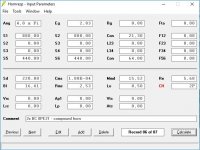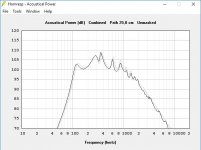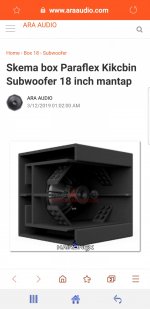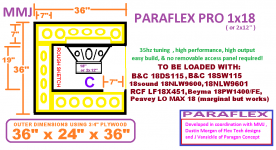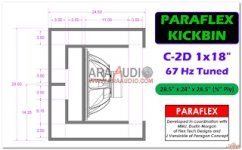I understand your intention - every bend costs bass-energy and dB at the end of the day. So that still has to be found out. 😉
There is that, and the issue of possible turbulence at that last bend, though the fairly large CSA should minimize that.
I doubt that the few cm of difference is going to make all that much difference to the coupling of the outputs, particularly at bass frequencies.
We have tried these types of cabinets both ways ... This whole adventure started off with the Super Planar subs a few years ago (you can see some in the very beginning of this discussion) which is the style without any merging at the ends of the resonators... Next we started exploring the Paraflex style which merges the ends of the paths to share a single large mouth as we see in Patrick's great Paraflex Type "R" example.... The builders & users have been reporting consistently better results with the Paraflex subs in regards to the improved behavior of the high-tuned resonator, improved sound quality, and improved pattern control .....
So we are seeing the Paraflex as the next step in this evolution of modernized Compound Loaded QW/Horn variant designs ..... Just moving forward with what has been working best for us .....
So we are seeing the Paraflex as the next step in this evolution of modernized Compound Loaded QW/Horn variant designs ..... Just moving forward with what has been working best for us .....
Last edited:
improved behavior of the high-tuned resonator, improved sound quality, and improved pattern control
By letting the bass pipe tapp into the large midbass resonator you will lower the Q of the bass pipe and add some positive acoustic feedback. Both will increase the sound quality substantially. Increasing punch and attack and lower compression at high power levels.
In the ROAR series we take these effects as far as we found reasonable without adding any unwanted complexity.
this is the most powerful subwoofer i've ever built!!
Have a look at the graphs and curves.
Sounds very strong, clear, punchy and also kicky!
This is exactly what is expected from large front resonators and acoustic positive feedback. Nice design and nice build!!! 🙂
I was inspired by this thread and also the debate at the FB group to try to find out in HornResp what a pair of 8PE21s could do in this arrangement. Here are some results. With a bit of EQ, I definitely see some potential. The folding would be like the C-2D split path kick bin a few posts back - but I think it will be a challenge to make the rear resonator with correct lenght. I guess I will need to make a small spreadsheet for that and play around with the numbers.
The pair of 8PE21s seems to go high enough to cross over to a reasonably sized horn with a 1" or 1.4" driver.
Anyway, I am waiting for the new super planar 2x8 to be released before cutting wood, this is just a mathematical exercise🙂
The pair of 8PE21s seems to go high enough to cross over to a reasonably sized horn with a 1" or 1.4" driver.
Anyway, I am waiting for the new super planar 2x8 to be released before cutting wood, this is just a mathematical exercise🙂
Attachments
Hey everybody! 🙂
The last few weeks Matthew and i worked out a Paraflex R-Type Subwoofer Cabinet. Driver is going to be the B&C 18DS115-4, but the actual measurements were taken with the RCF LF18G401-8.
From what i heard and tested so far (just measurements with the sub, playing some tracks just with the sub) i can say, that this is the most powerful subwoofer i've ever built!! 😎
Have a look at the graphs and curves.
Sounds very strong, clear, punchy and also kicky!
The best thing of all is the overall directivity =) i measured 1m at the front and 1m at the back and we have up to 15dB cancelation at the rear of the subwoofer (orange graph)! A passive cardiod-subwoofer so to speak.
If you have question, tell me!
Next days the DS-115-4 will be delivered and i will repeat the testing with that driver.
Note for the measurements: They were done with a calibrated Umik-1. The other subwoofer (green graph) is a Big Tham (MTH46VS with additional panels - longered the horn path like in the plan attached).
Regards,
Patrick
Nice build! I really like the view of the diagonal braces!
Brian, the bend of the path getting the rear path into the front resonator is the thing that makes it a paraflex. otherwise it's a Planar design, The paraflex is the next step in the evolution of the Planar design.
I have extensively tested the first Planar design subwoofer cabinet, the Super Planar 8 (SP8) , which has the rear path coming out at the front alongside the front resonator.
Although the PL8 did produce loud bass it was not sounding right to our ears. Not only was this cabinet extremely big but the drivers we tested (B&C 18DS115 and Oberton 18XB1500) sounded uncontrolled and sounded distressed and there were some resonances in the front resonator which where hard to control.
After that came the Pareflex Type-C where to rear path was inserted into the front chamber. Not only was this cabinet a lot smaller but it also sounded very controlled, had power plenty to spare, no driver stress at war volumes. It was a night and day difference in comparison to the much larger PL8.
But the PL8 was a spit path type so not really an apples to apples comparison to Type-c which uses a single path. So then we introduces the Type-C2E Design, which was a split path paraflex design like the PL8.
The step up to the C2E was an enlightenment in bandwidth and power output but also surprisingly big cancelation at the back, making it also a passive cardioid design. There are testimonials of the TC2E115 (15") TC2E118 (18") and even a contest build sponsored by B&C's Bennett Prescott called the TC2E-212 (2x12") Which later on was split in half by one of its builders to a TC2E-112 design.
Then there is also a TC2E-121 (21") of the design made by Mark Tomlin in England with great results. Currently there is a lot of exploration going on in different alternative-types. However none of the alterations have so extensively been measured and tested as the TC2E design.
I have extensively tested the first Planar design subwoofer cabinet, the Super Planar 8 (SP8) , which has the rear path coming out at the front alongside the front resonator.
Although the PL8 did produce loud bass it was not sounding right to our ears. Not only was this cabinet extremely big but the drivers we tested (B&C 18DS115 and Oberton 18XB1500) sounded uncontrolled and sounded distressed and there were some resonances in the front resonator which where hard to control.
After that came the Pareflex Type-C where to rear path was inserted into the front chamber. Not only was this cabinet a lot smaller but it also sounded very controlled, had power plenty to spare, no driver stress at war volumes. It was a night and day difference in comparison to the much larger PL8.
But the PL8 was a spit path type so not really an apples to apples comparison to Type-c which uses a single path. So then we introduces the Type-C2E Design, which was a split path paraflex design like the PL8.
The step up to the C2E was an enlightenment in bandwidth and power output but also surprisingly big cancelation at the back, making it also a passive cardioid design. There are testimonials of the TC2E115 (15") TC2E118 (18") and even a contest build sponsored by B&C's Bennett Prescott called the TC2E-212 (2x12") Which later on was split in half by one of its builders to a TC2E-112 design.
Then there is also a TC2E-121 (21") of the design made by Mark Tomlin in England with great results. Currently there is a lot of exploration going on in different alternative-types. However none of the alterations have so extensively been measured and tested as the TC2E design.
Not only was this cabinet a lot smaller
So, you made an entirely different cabinet. Which of course would have resulted in a different sound.
A more valid comparison would have been to take and existing paraflex cabinet and remove the last bend where the rear output is inserted into the end of the front output, to see if it makes any significant difference in its passband.
Now, if that rear output was inserted at the *start* of the front output, e.g. like the Cyclops design, then I'd expect to see a noticeable difference in output in the passband.
You are right of course, different designs although the PL8 and TC2E are very similar in design except the extra bend. However thanks to the PL8 we progressed to better things. And the large PL8 is RIP/abandoned for as it is now.
In my next 18" paraflex build i'm going to test your suggestion and compare measurements with and without extra panel. Since i'm very curious to see the differences in measurement and hearing difference.
In my next 18" paraflex build i'm going to test your suggestion and compare measurements with and without extra panel. Since i'm very curious to see the differences in measurement and hearing difference.
Brian, the bend of the path getting the rear path into the front resonator is the thing that makes it a paraflex. otherwise it's a Planar design, The paraflex is the next step in the evolution of the Planar design.
So, Paraflex = BP6S and Planar = BP6P?
Any thoughts on what the expected differences in output would be, if we allow ourselves to speculate a bit?Now, if that rear output was inserted at the *start* of the front output, e.g. like the Cyclops design, then I'd expect to see a noticeable difference in output in the passband.
The reason I'm asking is that (if I understand it correctly) apart from driver orientation and large qw resonator length this poposal is getting rather close to the ROAR designs, which is totaly fine, or am I missing something here?
So, Paraflex = BP6S and Planar = BP6P?
I thought BP6S = Band Pass 6th Order Series tuned and
BP6P = Band Pass 6th Order Parallel tuned
I thought BP6S = Band Pass 6th Order Series tuned and
BP6P = Band Pass 6th Order Parallel tuned
They do. The Paraflex looks like a BP6S and the Planar looks like a BP6P.
Double word-squish
BP1Fan and LayinLo,
The name Paraflex is a double portmanteau, and by that i mean it is a word we created by joining two other words that relate to the item in some way ....
.... An old name for a quarterwave resonant pipe with the driver tucked into the mouth was called the "Transflex" and is considered a series-tuned 6th order design and in addition to that old classic we have included another resonator into the system which adds a parallel-tuned aspect to our design for a combination of both parallel-tuned and series-tuned topology all at the same time, therefore it is a Parallel-Transflex hybrid, or again Paraflex for short .............. HOWEVER, that is not all, this also works on another level .
.
........... The three founding fathers of the Paraflex include myself with Dustin Morgan and J.R. Vansickle .... Dustin's company is called "Flex Tech" and Mr Vansickle's company is called Paragon Concept , so if we combine the first two words of their companies we end up with Para-Flex which we could say is short for Paragon-Flex Tech 😀....... ......
They do. The Paraflex looks like a BP6S and the Planar looks like a BP6P.
BP1Fan and LayinLo,
The name Paraflex is a double portmanteau, and by that i mean it is a word we created by joining two other words that relate to the item in some way ....
.... An old name for a quarterwave resonant pipe with the driver tucked into the mouth was called the "Transflex" and is considered a series-tuned 6th order design and in addition to that old classic we have included another resonator into the system which adds a parallel-tuned aspect to our design for a combination of both parallel-tuned and series-tuned topology all at the same time, therefore it is a Parallel-Transflex hybrid, or again Paraflex for short .............. HOWEVER, that is not all, this also works on another level
 .
............ The three founding fathers of the Paraflex include myself with Dustin Morgan and J.R. Vansickle .... Dustin's company is called "Flex Tech" and Mr Vansickle's company is called Paragon Concept , so if we combine the first two words of their companies we end up with Para-Flex which we could say is short for Paragon-Flex Tech 😀....... ......
Last edited:
Also, it is important to keep in mind that the Low-Tuned section in the Super-Planar & Paraflex series of Compound Loaded cabinets are thus far all quarterwave based resonators, (instead of helmholtz/reflex based resonator systems), making this family of designs less related to basic BP boxes and more closely related to Compound Horns .....
Some of our LF-QW resonators have an expanding Cross Sectional Area and some do not ....
I do have an alternative LF-resonator idea or two, things that i have tinkered around with in simulation.... It is possible that a new twist on the Paraflex design might emerge out of these experiments but so far the QW resonators (and in some cases QW resonators with some expansion in the path) have been working very well for us ....
....
The High-Tuned resonator in these designs aren't always a purely Quarterwave resonator, but in those cases it isn't a Helmholtz resonator either (no physical constriction for mass loading purposes)......................
When it comes to the subwoofers we have found that the longer High-Tuned resonators (meaning the ones which are more QW-ish) have been generally preferable.. .
Some of our LF-QW resonators have an expanding Cross Sectional Area and some do not ....
I do have an alternative LF-resonator idea or two, things that i have tinkered around with in simulation.... It is possible that a new twist on the Paraflex design might emerge out of these experiments but so far the QW resonators (and in some cases QW resonators with some expansion in the path) have been working very well for us
 ....
....The High-Tuned resonator in these designs aren't always a purely Quarterwave resonator, but in those cases it isn't a Helmholtz resonator either (no physical constriction for mass loading purposes)......................
When it comes to the subwoofers we have found that the longer High-Tuned resonators (meaning the ones which are more QW-ish) have been generally preferable.. .
Last edited:
This showed up on my Pinterest page on 12-3-19.
Yes, it is a Paraflex C-2D kickbin and that beautiful rendering is made by our friend Ty "Kaironex" Cention ..
Ari or Ara from Bintang Audio Indonesia likes to use Ty's 3D artwork to promote his business in Asia ..
[/QUOTE]This poposal is getting rather close to the ROAR designs, which is totaly fine, or am I missing something here?
Hello Martinsson!

The Paraflex is a different topology of course (not the same as a ROAR or Tapped Horn) but the discussion went into talking about modifications along with comparisons to other designs which can create confusion .... A few of the proposed alterations would turn the cabinet into something other than a Paraflex ..
Any thoughts on what the expected differences in output would be, if we allow ourselves to speculate a bit?
No need to speculate in that case .. We have had the Paraflex cabinets measured against similarly sized Tapped Horns of the same tuning loaded with the same driver, same room/location, same amp, same conditions....The Paraflex pulls ahead on average below 120hz (within the range where most folks would be using the cabinet), yet is roughly a match within the 40hz to 50hz region. .....
This (below) is a Paraflex Type "C" classic versus an XOC1 TH118 :

Last edited:
Response to Johannes and some additional sharing of thoughts
Thank You so much Circlomanen.... Patrick did a fantastic job on that build and he made the 3D images too 🙂 Patrick and I have been talking about how we may further improve upon and the design by making the High-Tuned resonator longer/deeper, so there may be a new revision of the Type "R" 1x18" in the near future ..
Anyway, Johannes, so glad to have your blessing on this ...... ... ..As USRFobiwan is saying in Post #1066 this approach has allowed us to overcome some of the challenges that we were facing in the Super Planar subwoofer designs ........ .... We knew that merging the ends of the resonator paths to share a single large mouth would alter the Q of the LF-QW resonator by making it a little more resonant at Fb (allowing us to reduce overall cabinet size compared to the awkwardly Large Super Planar 8th subs, this is easy enough to see in the Hornresp model) but we didn't expect that it would reduce the Q of the High-Tuned resonator thereby solving a "ringing" resonator issue that the Sp8th subs suffered from (we have found that with this merged resonator Paraflex there is no need to add damping material to tame that resonator), and this is also surely a factor in the improved sound quality (relative to the old Sp8th efforts) .....We are grateful for this improvement , ....
, ....
We had also received a few complaints about the large Super Planar subs not being directional enough, but that problem also seems to be remedied in the Paraflex series..........
So as far as we can tell this increased resonator coupling (and perhaps some volume sharing effects) is apparently helpful ..... I suspect that the end of the LF-QW resonator may be utilizing the High-Tuned resonator as attached volume acting as an interface for the shared mouth, so if this is the case then the volume in the High-Tuned resonator is doing double-duty to some extent .... This is just theory (in an attempt to explain some of the observed effects)......
Nevertheless we would prefer to project our LF output from a mouth with large area (as opposed to the end of a relatively small resonator duct) even if it is just for practical purposes such as eliminating the potential for undesirable air particle velocity related issues when using grill & foam material directly over the front of a cabinet, but if taking this approach also benefits us in additional ways then we are understandably delighted and excited ..... We aren't done yet though ..... As a better understanding of these designs continues to be developed there should be further refinements if at all practical & possible (such as a new revision of Patrick's Type "R" for example, which is mentioned above) . .
..... We aren't done yet though ..... As a better understanding of these designs continues to be developed there should be further refinements if at all practical & possible (such as a new revision of Patrick's Type "R" for example, which is mentioned above) . .
By letting the bass pipe tapp into the large midbass resonator you will lower the Q of the bass pipe and add some positive acoustic feedback. Both will increase the sound quality substantially. Increasing punch and attack and lower compression at high power levels.
In the ROAR series we take these effects as far as we found reasonable without adding any unwanted complexity.
This is exactly what is expected from large front resonators and acoustic positive feedback. Nice design and nice build!!! 🙂
Thank You so much Circlomanen.... Patrick did a fantastic job on that build and he made the 3D images too 🙂 Patrick and I have been talking about how we may further improve upon and the design by making the High-Tuned resonator longer/deeper, so there may be a new revision of the Type "R" 1x18" in the near future ..
Anyway, Johannes, so glad to have your blessing on this ...... ... ..As USRFobiwan is saying in Post #1066 this approach has allowed us to overcome some of the challenges that we were facing in the Super Planar subwoofer designs ........ .... We knew that merging the ends of the resonator paths to share a single large mouth would alter the Q of the LF-QW resonator by making it a little more resonant at Fb (allowing us to reduce overall cabinet size compared to the awkwardly Large Super Planar 8th subs, this is easy enough to see in the Hornresp model) but we didn't expect that it would reduce the Q of the High-Tuned resonator thereby solving a "ringing" resonator issue that the Sp8th subs suffered from (we have found that with this merged resonator Paraflex there is no need to add damping material to tame that resonator), and this is also surely a factor in the improved sound quality (relative to the old Sp8th efforts) .....We are grateful for this improvement
 , ....
, .... We had also received a few complaints about the large Super Planar subs not being directional enough, but that problem also seems to be remedied in the Paraflex series..........
So as far as we can tell this increased resonator coupling (and perhaps some volume sharing effects) is apparently helpful ..... I suspect that the end of the LF-QW resonator may be utilizing the High-Tuned resonator as attached volume acting as an interface for the shared mouth, so if this is the case then the volume in the High-Tuned resonator is doing double-duty to some extent .... This is just theory (in an attempt to explain some of the observed effects)......
Nevertheless we would prefer to project our LF output from a mouth with large area (as opposed to the end of a relatively small resonator duct) even if it is just for practical purposes such as eliminating the potential for undesirable air particle velocity related issues when using grill & foam material directly over the front of a cabinet, but if taking this approach also benefits us in additional ways then we are understandably delighted and excited
 ..... We aren't done yet though ..... As a better understanding of these designs continues to be developed there should be further refinements if at all practical & possible (such as a new revision of Patrick's Type "R" for example, which is mentioned above) . .
..... We aren't done yet though ..... As a better understanding of these designs continues to be developed there should be further refinements if at all practical & possible (such as a new revision of Patrick's Type "R" for example, which is mentioned above) . .
Last edited:
They do. The Paraflex looks like a BP6S and the Planar looks like a BP6P.
BP1Fan and LayinLo,
The name Paraflex is a double portmanteau, and by that i mean it is a word we created by joining two other words that relate to the item in some way ....
.... An old name for a quarterwave resonant pipe with the driver tucked into the mouth was called the "Transflex" and is considered a series-tuned 6th order design and in addition to that old classic we have included another resonator into the system which adds a parallel-tuned aspect to our design for a combination of both parallel-tuned and series-tuned topology all at the same time, therefore it is a Parallel-Transflex hybrid, or again Paraflex for short .............. HOWEVER, that is not all, this also works on another level.
........... The three founding fathers of the Paraflex include myself with Dustin Morgan and J.R. Vansickle .... Dustin's company is called "Flex Tech" and Mr Vansickle's company is called Paragon Concept , so if we combine the first two words of their companies we end up with Para-Flex which we could say is short for Paragon-Flex Tech 😀....... ......
Also, it is important to keep in mind that the Low-Tuned section in the Super-Planar & Paraflex series of Compound Loaded cabinets are thus far all quarterwave based resonators, (instead of helmholtz/reflex based resonator systems), making this family of designs less related to basic BP boxes and more closely related to Compound Horns .....
Some of our LF-QW resonators have an expanding Cross Sectional Area and some do not ....
I do have an alternative LF-resonator idea or two, things that i have tinkered around with in simulation.... It is possible that a new twist on the Paraflex design might emerge out of these experiments but so far the QW resonators (and in some cases QW resonators with some expansion in the path) have been working very well for us....
The High-Tuned resonator in these designs aren't always a purely Quarterwave resonator, but in those cases it isn't a Helmholtz resonator either (no physical constriction for mass loading purposes)......................
When it comes to the subwoofers we have found that the longer High-Tuned resonators (meaning the ones which are more QW-ish) have been generally preferable.. .
I was able to sort out the naming convention a while back when I first started researching these. I'm glad BP1 made the comment! We were talking about the same thing but I didn't realize he was clarifying it further. So I learned something new...thank you. And thank you M J Morgan for being so active and responsive in this thread. Your passion is obvious and admirable.

As I type this I'm eyeing a pair of 15's that may get some Hornresp attention tonight for possibly working them into an automotive build using your generous research as a guide. I don't compete anymore but it is fun to show up and have a bit of fun with the younger ones who are new to it. Age and treachery > youth and exuberance, right? 😉
We knew that merging the ends of the resonator paths to share a single large mouth would alter the Q of the LF-QW resonator by making it a little more resonant at Fb (allowing us to reduce overall cabinet size compared to the awkwardly Large Super Planar 8th subs, this is easy enough to see in the Hornresp model) but we didn't expect that it would reduce the Q of the High-Tuned resonator thereby solving a "ringing" resonator issue that the Sp8th subs suffered from (we have found that with this merged resonator Paraflex there is no need to add damping material to tame that resonator), and this is also surely a factor in the improved sound quality (relative to the old Sp8th efforts) .....We are grateful for this improvement, ....
We had also received a few complaints about the large Super Planar subs not being directional enough, but that problem also seems to be remedied in the Paraflex series..........
So as far as we can tell this increased resonator coupling (and perhaps some volume sharing effects) is apparently helpful ..... I suspect that the end of the LF-QW resonator may be utilizing the High-Tuned resonator as attached volume acting as an interface for the shared mouth, so if this is the case then the volume in the High-Tuned resonator is doing double-duty to some extent .... This is just theory (in an attempt to explain some of the observed effects)
Does the shared mouth function perform better with a split path exit into the larger chamber?
Attachments
Last edited:
- Home
- Loudspeakers
- Subwoofers
- Compound loading 6th order quarterwave "Super Planar" horns and pipes concepts/builds
